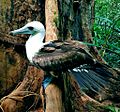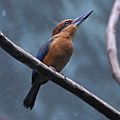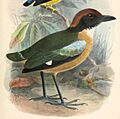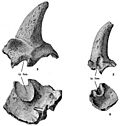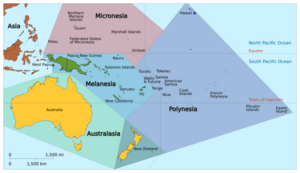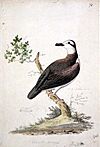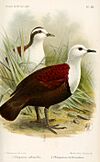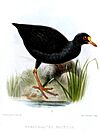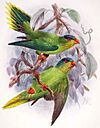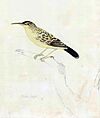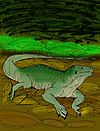Many extinction dates are unknown due to a lack of relevant information.
| Common name |
Scientific name |
Range |
Comments |
Pictures |
| Henderson archaic pigeon |
Bountyphaps obsoleta |
Henderson Island, Pitcairn |
Most recent remains from Polynesian middens dated to 1000-1600 CE. It was the largest of four pigeon species originally present in the island, and a poor flier but not flightless. It was likely hunted to extinction. |
|
| Kanaka pigeon |
Caloenas canacorum |
New Caledonia; possibly Vanuatu and Fiji |
Most recent remains at the Pindai Caves dated to 86-428 CE. It was likely hunted to extinction. Remains provisionally assigned to this taxon in Tonga likely belong to a different species. |
|
|
Caloenas sp. |
Tonga |
Known from subfossil remains. |
| Spotted green pigeon |
Caloenas maculata |
unknown, possibly Tahiti, French Polynesia |
Known from two specimens of unknown origin that were collected in 1783 and 1823, believed to have come from somewhere in the Pacific Ocean. Its coloration suggests that it was a forest-dweller, and its short and rounded wings that it evolved in a predator-free island. 1928 native accounts of a bird in Tahiti may refer to this species. It could have disappeared due to hunting or introduced predators before extensive European exploration of the Pacific. |
 |
| Tongan tooth-billed pigeon |
Didunculus placopedetes |
Tonga |
Most recent remains dated to 900-750 BCE. |
|
| David's imperial pigeon |
Ducula david |
Ouvéa Island, New Caledonia |
Most recent remains at Utuleve dated to 550-50 BCE. |
|
| Henderson imperial pigeon |
Ducula harrisoni |
Henderson Island, Pitcairn |
Most recent remains dated to 1000-1600 CE. |
|
| Lakeba pigeon |
Ducula lakeba |
Lakeba and Aiwa Levu, Fiji |
Most recent remains dated to around 850 BCE. |
|
|
Ducula shutleri |
Tonga |
Known from subfossil remains dated to 855-730 BCE. |
|
| Rota large ground dove |
Gallicolumba sp. |
Rota, Mariana Islands |
Known from subfossil remains. Coexisted with the smaller Micronesian pigeon, now extirpated from the Marianas. |
| Huahine cuckoo-dove |
Macropygia arevarevauupa |
Huahine, Society Islands, French Polynesia |
Most recent remains at Fa'ahia dated to 700-1150 CE. |
|
| Marquesas cuckoo-dove |
Macropygia heana |
Nuku Hiva and Ua Huka, Marquesa Islands |
Most recent remains at Hane, Ua Huka dated to 300-1200 CE. |
|
| Choiseul pigeon |
Microgoura meeki |
Choiseul, and speculatively Bougainville and Malaita, Solomon Islands |
Not recorded since 1904; more recent observations are believed to be confusions with other doves and pigeons. It was probably exterminated by introduced dogs and cats. |
|
| Viti Levu giant pigeon |
Natunaornis gigoura |
Viti Levu, Fiji |
Known from subfossil remains. It was the third largest pigeon ever after the dodo and Rodrigues solitaire, flightless and adapted to eat large fruit, seeds, and insects on the ground. Like the former, it would have been extremely vulnerable to hunting and introduced mammals predating on its eggs and chicks. |
 |
| Mangaia ground dove |
Pampusana erythroptera ssp. |
Mangaia, Cook Islands |
Known from subfossil remains. |
|
| Society Islands ground dove |
Pampusana erythroptera ssps. |
Moorea and Tahiti, French Polynesia |
Known from a few specimens collected between 1768 and 1779 (mostly lost), paintings and descriptions. Differences in the paintings suggest that they represent two undescribed subspecies. Two other subspecies were described in the Tuamotu Islands, where at least one survives. |
|
| Tanna ground dove |
Pampusana ferruginea |
Tanna Island, Vanuatu |
Only known from a 1774 painting by Georg Forster. |
 |
| Henderson ground dove |
Pampusana leonpascoi |
Henderson Island, Pitcairn |
Most recent remains dated to 1000-1600 CE. |
|
| New Caledonian ground dove |
Pampusana longitarsus |
New Caledonia |
Most recent remains at the Pindai Caves dated to 86-428. |
|
| Great ground dove |
Pampusana nui |
Marquesas, Cook, Society, and Tuamotu Islands |
Most recent remains in Mangaia dated to 1390-1470 CE. |
|
| Thick-billed ground dove |
Pampusana salamonis |
Makira and Ramos, Solomon Islands |
Known from one individual collected in Makira in 1882 and another from Ramos in 1927. Likely declined due to hunting, predation by introduced rats and cats, and habitat destruction. |
|
| Red-moustached fruit dove |
Ptilinopus mercierii |
Nuku Hiva and Hiva Oa, Marquesa Islands, French Polynesia |
Only recorded in Nuku Hiva when the holotype was collected in 1836-1839, and last recorded in Hiva Oa in 1922. A record from 1980 was mistaken. Disappeared due to predation by introduced great horned owls, cats, and rats. |
 |
| Mauke fruit dove |
Ptilinopus rarotongensis byronensis |
Mauke, Cook Islands |
Only known from a 1825 description by Andrew Bloxam. |
|
| Common name |
Scientific name |
Range |
Comments |
Pictures |
| Nuku Hiva rail |
Hypotaenidia epulare |
Nuku Hiva, Marquesas Islands |
Most recent remains dated to around 950 CE. The remains were found in middens along with other vertebrate bones and shells of animals consumed by Polynesians. It was probably hunted to extinction. |
|
| Ua Huka rail |
Hypotaenidia gracilitibia |
Ua Huka, Marquesas Islands |
Most recent remains dated to around 600 CE. |
| Niue rail |
Hypotaenidia huiatua |
Niue |
Known from subfossil remains predating human settlement, but believed to have been driven to extinction by hunting or anthropogenic changes to its environment. |
|
| Tongatapu rail |
Hypotaenidia hypoleucus |
Tongatapu, Tonga |
Known from John Latham's 1785 description of birds collected by William Anderson during the third voyage of James Cook (1776-1780). The species was likely exterminated by feral dogs introduced by Cook's previous visit in 1773. |
 |
| Tahiti rail |
Hypotaenidia pacifica |
Tahiti and Mehetia, Society Islands, French Polynesia |
Last reported in Tahiti in 1844 and in Mehetia in the 1930s. It was flightless. Its extinction was presumably caused by introduced cats and rats. |
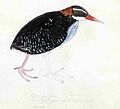 |
| Tinian rail |
Hypotaenidia pendiculentus |
Tinian, Mariana Islands |
Known from subfossil remains. |
|
| Aguiguan rail |
Hypotaenidia pisonii |
Aguiguan, Mariana Islands |
Known from subfossil remains, nearly all of which show charring from cooking fires. |
|
| Bar-winged rail |
Hypotaenidia poeciloptera |
Viti Levu and Ovalau, Fiji |
Last seen with certainty before 1890. There were unconfirmed sightings in Taveuni in 1971, and in Waisa, Viti Levu in 1973. It was possibly exterminated by introduced cats and mongooses. |
 |
| Mangaia rail |
Hypotaenidia ripleyi |
Mangaia, Cook Islands |
Known from subfossil remains. Likely extinct due to hunting, habitat alteration, and introduction of mammalian predators. |
|
| Tahuata rail |
Hypotaenidia roletti |
Tahuata, Marquesas Islands |
Most recent remains dated to around 950 CE. One of only two known rails from eastern Polynesia, it was likely flightless and had robust legs adapted to a terrestrial lifestyle. As a result, it would have been extremely vulnerable to humans and introduced predators. |
|
| Tabuai rail |
Hypotaenidia steadmani |
Tabuai, Austral Islands, French Polynesia |
Known from subfossil remains. It possibly disappeared around 1300 CE, soon after the arrival of Polynesians. |
|
| Huahine rail |
Hypotaenidia storrsolsoni |
Huahine, Society Islands, French Polynesia |
Most recent remains at Fa'ahia dated to 700-1150 CE. Its remains were found in Polynesian middens, and it likely disappeared due to hunting or predation by introduced mammals. |
|
| Rota rail |
Hypotaenidia temptatus |
Rota, Mariana Islands |
Known from subfossil remains. |
|
| Vava'u rail |
Hypotaenidia vavauensis |
Vava'u, Tonga |
Depicted alive by the Malaspina Expedition in 1793. Its existence was confirmed with the finding of Lapita culture remains in 2004-2014. |
 |
| Eua rail |
Hypotaenidia vekamatolu |
ʻEua, Tonga |
Known from subfossil remains. It disappeared between the arrival of Polynesians around 1300 and Europeans in 1800. |
|
| Wake Island rail |
Hypotaenidia wakensis |
Wake and Wilkes Island |
Likely hunted to extinction by besieged Japanese Empire troops during the World War II occupation of Wake Island. |
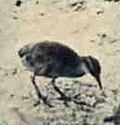 |
| Hiva Oa rail |
Hypotaenidia sp. |
Hiva Oa, Marquesas Islands |
One of only two rail species from eastern Polynesia. It was flightless. |
|
| New Caledonian gallinule |
Porphyrio kukwiedei |
New Caledonia |
Most recent remains at the Pindai Caves dated to 86-428 CE. A possible native name, n'dino, was recorded in 1860. |
|
| Huahine swamphen |
Porphyrio mcnabi |
Huahine, Society Islands, French Polynesia |
Most recent remains at Fa'ahia dated to 700-1150 CE. |
|
| Marquesas swamphen |
Porphyrio paepae |
Hiva Oa and Tahuata, Marquesas Islands, French Polynesia |
Though described from subfossil remains, it could have survived until the 20th century on account of a gallinule depicted being hunted by a dog on the 1902 painting Le Sorcier d'Hiva Oa, by Paul Gauguin. Thor Heyerdahl also observed a similar bird in 1937. |
 |
| Rota swamphen |
Porphyrio sp. |
Rota, Mariana Islands |
Known from subfossil remains. |
|
| Viti Levu rail |
Vitirallus watlingi |
Viti Levu, Fiji |
Known from subfossil remains. It was apparently restricted to lowlands, which would be more susceptible to fires. Likely disappeared due to hunting, habitat destruction, and predation by introduced mammals like the Polynesian rat. |
| Kosrae crake |
Zapornia monasa |
Kosrae, Micronesia |
Known from two individuals collected in 1827-1828. Considered sacred by the natives and not hunted, it likely disappeared due to predation by rats, which were plentiful by the time ornithologists fruitlessly searched for the bird again, in 1880. |
|
| Tahiti crake |
Zapornia nigra |
Tahiti, Society Islands, and possibly Mangaia, Cook Islands |
Depicted by Georg Forster during Cook's second voyage (1772-1775); John Frederick Miller's more famous painting from 1784 is a copy. It disappeared soon after from Tahiti but it or a similar species (different from Zapornia rua) could have survived in Mangaia until recently. |
 |
| Mangaia crake |
Zapornia rua |
Mangaia, Cook Islands |
Known from subfossil remains. |
|
| Easter Island crake |
Zapornia sp. |
Easter Island, Chile |
Disappeared between 1000 and 1430 CE. |
|
| Buka swamphen |
Porphyrio sp. |
Buka Island, Autonomous Region of Bougainville |
Prehistoric |
|
| Easter Island rail |
Rallidae incertae sedis |
Easter Island, Chile |
Disappeared between 1000 and 1430 CE. |
|
|
Rallidae incertae sedis |
Tonga |
A species of size intermediate between H. vavauensis and H. philippensis, dated to 855-730 BCE. |
| Common name |
Scientific name |
Range |
Comments |
Pictures |
| Viti Levu snipe |
Coenocorypha miratropica |
Viti Levu, Fiji |
Known from subfossil remains. Probably disappeared due to predation by introduced pigs, dogs, and Polynesian rats. |
|
| New Caledonian snipe |
Coenocorypha neocaledonica |
New Caledonia |
Known from two subfossil humeri and a coracoid. Probably driven to extinction by introduced rats. |
|
| Christmas sandpiper |
Prosobonia cancellata |
Kiritimati, Kiribati |
Only known from the type, collected in 1778 and subsequently lost. It was probably exterminated by invasive cats. |
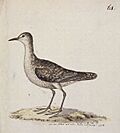 |
| Moorea sandpiper |
Prosobonia ellisi |
Moorea, Society Islands, French Polynesia |
Only known from two paintings based on individuals collected during Cook's third voyage in 1777, and subsequently lost. Some authors suggest it was the same species as the Tahiti sandpiper, while others defend its specific status on plumage differences. In the absence of specimens, the species must be considered dubious. It was probably exterminated by invasive mammals, though habitat destruction could have been another factor. |
 |
| Tahiti sandpiper |
Prosobonia leucoptera |
Tahiti, Society Islands, French Polynesia |
Known from an individual collected during Cook's voyage in 1773. It could have been driven to extinction by habitat destruction caused by invasive pigs and goats, or predation by rats. |
|
| Common name |
Scientific name |
Range |
Comments |
Pictures |
| Raiatea parakeet |
Cyanoramphus ulietanus |
Raiatea, Society Islands, French Polynesia |
Known from two individuals generally believed to have been collected during Cook's second voyage in 1773 or 1774, though 1777 during the third voyage is also possible. |
|
| Black-fronted parakeet |
Cyanoramphus zealandicus |
Tahiti, Society Islands, French Polynesia |
Last collected in 1844. It could have become extinct due to habitat loss, hunting, or predation by introduced species. |
|
| Oceanic eclectus |
Eclectus infectus |
'Eua, Lifuka, Uiha, and Vava'u in Tonga; possibly also Vanuatu and Fiji |
Described from subfossil remains. A live bird from Vava'u was likely depicted by members of the Malaspina Expedition in 1793. It presumably became extinct soon after due to hunting and predation by introduced mammals. |
 |
| Sinoto's lorikeet |
Vini sinotoi |
Marquesas and Society Islands |
Most recent remains dated to 810-1025 CE. It could have become extinct due to predation by Polynesian rats. |
|
| Conquered lorikeet |
Vini vidivici |
Marquesas, Society, and Cook Islands |
Most recent remains dated to 1000-1200 CE. It could have become extinct due to predation by Polynesian rats. |
 |
| Easter Island parrots |
Psittaciformes incertae sedis |
Easter Island, Chile |
Two species extinct between 1000 and 1430 CE. |
|
| Common name |
Scientific name |
Range |
Comments |
Pictures |
| Mangareva reed warbler |
Acrocephalus astrolabii |
unknown; possibly the Gambier Islands, French Polynesia |
Known only from two individuals collected by Jules Dumont d'Urville in either 1826-1829 or 1838-1839. Likely disappeared due to deforestation and introduced predators. |
|
| Moorea reed warbler |
Acrocephalus longirostris |
Moorea, Society Islands, French Polynesia |
Last recorded in 1973; a later reported observation is unconfirmed. It probably disappeared due to severe deforestation, predation by introduced mammals, or avian malaria which was introduced to the island in the 1970s. |
|
| Nightingale reed warbler |
Acrocephalus luscinius |
Guam |
Last recorded in 1969. It was driven to extinction by the introduced predatory brown tree snake. Habitat loss caused by fire and drainage of wetlands, pesticide use, and additional introduced predators like cats and rats were also contributing factors. |
 |
| Huahine warbler |
Acrocephalus musae garretti |
Huahine, Society Islands, French Polynesia |
Only known from five individuals collected around 1869. It likely became extinct due to predation by introduced rats. |
|
| Raiatea warbler |
Acrocephalus musae musae |
Raiatea, Society Islands, French Polynesia |
Last collected between 1870 and 1873. |
|
| Aguijan reed warbler |
Acrocephalus nijoi |
Aguiguan, Mariana Islands |
Last recorded in the mid-1990s. Extinct due to habitat loss caused by deforestation and grazing by introduced goats. |
|
| Pagan reed warbler |
Acrocephalus yamashinae |
Pagan, Mariana Islands |
Last recorded in the 1970s. It was made extinct by draining its wetland habitat for agriculture, grazing feral livestock destroying the understorey, which it used to breed, predation by introduced cats and rats, and general increase in land use by the military. If still alive in 1981, it might have been wiped out by a volcanic eruption that destroyed much of the remaining woody vegetation. |
|
| Common name |
Scientific name |
Range |
Comments |
Pictures |
| Guam flycatcher |
Myiagra freycineti |
Guam |
Once common through the island, its population crashed rapidly after brown tree snakes were introduced, becoming restricted to the northern plateau in 1971, then to the Pajon Basin in early 1983. By the time a captive breeding program was set up in October of the same year, only one male could be found and captured. This animal died in captivity in May 1984 of unknown causes. Introduced diseases could also have contributed to its extinction. |
 |
|
Myiagra sp. |
Ua Huka, Marquesas Islands, French Polynesia |
Known from subfossil remains. |
|
| Eiao monarch |
Pomarea fluxa |
Eiao, Marquesas Islands, French Polynesia |
Last recorded in 1977. Disappeared soon after the chestnut-breasted mannikin was introduced to the island, implying that a exotic avian disease was transmitted to the population. The species may have also declined earlier due to habitat loss caused by sheep grazing, and predation by feral cats, black rats, and Polynesian rats. |
|
| Nuku Hiva monarch |
Pomarea nukuhivae |
Nuku Hiva, Marquesas Islands, French Polynesia |
Last recorded in the 1930s. Declined due to habitat loss caused by intense grazing and fire, and predation by introduced species including the black rat. |
|
| Maupiti monarch |
Pomarea pomarea |
Maupiti, Society Islands, French Polynesia |
Known only from the type specimen, collected in 1823. It was likely driven extinct by introduced species. |
 |
| Common name |
Scientific name |
Range |
Comments |
Pictures |
| Huahine Tiny Tree Snail |
Partula arguta |
Huahine, Society Islands, French Polynesia |
Exterminated by the introduced predatory snail Euglandina rosea. Individuals were captured for a breeding program, but it ended with the death of the last captive animal in 1994. |
|
| Raiatean Ground Partula |
Partula atilis |
Raiatea, Society Islands, French Polynesia |
Last recorded in 1992. Exterminated by E. rosea. |
|
| Golden Partula |
Partula aurantia |
Moorea, Society Islands, French Polynesia |
Not recorded since E. rosea was introduced in 1977. |
|
| Auriculate Tree Snail |
Partula auriculata |
Raiatea, Society Islands, French Polynesia |
Last recorded in 1992. Exterminated by E. rosea. |
|
| Tahaa Banded Tree Snail |
Partula bilineata |
Taha'a, Society Islands, French Polynesia |
Not recorded since E. rosea was introduced in the 1980s. |
|
| Thick-Lipped Tree Snail |
Partula crassilabris |
Raiatea, Society Islands, French Polynesia |
Believed exterminated by E. rosea around 1991-1992. |
|
| Raiatean Banded Tree Snail |
Partula cuneata |
Raiatea, Society Islands, French Polynesia |
Last recorded in 1992. Exterminated by E. rosea. |
|
| Aphrodite's Tree Snail |
Partula cytherea |
Papenoo valley, Tahiti, French Polynesia |
Not recorded since E. rosea was introduced in 1977. |
|
| Raiatean Streaked Tree Snail |
Partula dolichostoma |
Raiatea, Society Islands, French Polynesia |
Last recorded in 1992. Exterminated by E. rosea. |
|
| Slender Mountain Tree Snail |
Partula dolorosa |
Raiatea, Society Islands, French Polynesia |
Last recorded in 1992. Exterminated by E. rosea. |
|
| Tahaa Hermit Tree Snail |
Partula eremita |
Taha'a, Society Islands, French Polynesia |
Not recorded since E. rosea was introduced in the late 1980s. |
|
| Burch's Partula |
Partula jackieburchi |
Tahiti, Society Islands, French Polynesia |
Not recorded after E. rosea was introduced in 1977. |
|
| Vinuous Tree Snail |
Partula labrusca |
Raiatea, Society Islands, French Polynesia |
Not recorded in the wild since 1992 due to predation by E. rosea. The last captive animal died in 2002. |
|
| Thin-Lipped Tree Snail |
Partula leptochila |
Raiatea, Society Islands, French Polynesia |
Last recorded in 1992. Exterminated by E. rosea. |
|
| Raiatean Ground Partula |
Partula levistriata |
Raiatea, Society Islands, French Polynesia |
Last recorded in 1992. Exterminated by E. rosea. |
|
| Bora Bora Tree Snail |
Partula lutea |
Bora Bora, Society Islands, French Polynesia |
Not recorded since E. rosea was introduced in 1986. |
 |
| Tahaa Large Tree Snail |
Partula planilabrum |
Tahaa, Society Islands, French Polynesia |
Not recorded since E. rosea was introduced in the late 1980s. |
|
| Tahitian Banded Tree Snail |
Partula producta |
Faurahi Valley, Tahiti, French Polynesia |
Not recorded since E. rosea was introduced in 1977. |
|
| Raiatean Banded Partula |
Partula protracta |
Raiatea, Society Islands, French Polynesia |
Thought to have disappeared around 1991-1992 because of predation by E. rosea, introduced in the late 1980s. |
|
| Remote Tree Snail |
Partula remota |
Raiatea, Society Islands, French Polynesia |
Thought to have disappeared around 1991-1992 because of predation by E. rosea, introduced in the late 1980s. |
|
| Mount Alifana partula |
Partula salifana |
Guam |
|
|
| Arrow-head tree snail |
Partula sagitta |
Tahaa, Society Islands, French Polynesia |
Not recorded since E. rosea was introduced in the late 1980s. |
|
| Swollen Raiatea tree snail |
Partula turgida |
Raiatea, Society Islands, French Polynesia |
Last recorded in the wild in 1992, due to predation by E. rosea. The last individual in captivity died in 1996. |
 |
| Tahaa Squat Tree Snail |
Partula umbilicata |
Tahaa, Society Islands, French Polynesia |
Not recorded since E. rosea was introduced in the late 1980s. |
|
| Common name |
Scientific name |
Range |
Comments |
Pictures |
| Toothed Partula |
Partula dentifera |
Raiatea, Society Islands, French Polynesia |
Last recorded in the wild in 1992 as a result of predation by E. rosea. |
|
| Captain Cook's bean snail |
Partula faba |
Raiatea and Taha'a, Society Islands, French Polynesia |
Last recorded in the wild in 1992 as a result of predation by E. rosea. Only individuals from Raiatea survive in captivity. |
 |
| Rose-tipped partula snail |
Partula hebe |
Raiatea, Society Islands, French Polynesia |
Last recorded in the wild in 1992 because of predation by E. rosea. |
 |
| Miracle Tree Snail |
Partula mirabilis |
Moorea, Society Islands, French Polynesia |
Not recorded in the wild since E. rosea was introduced in 1977. |
|
| Moorean Smooth Tree Snail |
Partula mooreana |
Moorea, Society Islands, French Polynesia |
Not recorded in the wild since E. rosea was introduced in 1977. A reintroduction program began in 2016. |
 |
| Raiatean ground partula snail |
Partula navigatoria |
Raiatea, Society Islands, French Polynesia |
The last known wild individuals were taken for a captive breeding program in 1992. The species was reintroduced in 2016. |
|
| Tahitian Nodular Partula |
Partula nodosa |
Tahiti, Society Islands, French Polynesia |
Not recorded in the wild since E. rosea was introduced in 1977. |
|
| Pink Partula |
Partula rosea |
Huahine, Society Islands, French Polynesia |
Not recorded in the wild since E. rosea was introduced in the early 1990s. |
 |
| Sutural partula |
Partula suturalis |
Moorea, Society Islands, French Polynesia |
Not recorded in the wild since E. rosea was introduced in 1977. |
 |
| Mount Tohiea Tree Snail |
Partula tohiveana |
Fareahito valley, Moorea, French Polynesia |
Not recorded in the wild since E. rosea was introduced in 1977. |
 |
| Mourning Partula |
Partula tristis |
Raiatea, French Polynesia |
Last recorded in the wild in 1992 as a result of predation by E. rosea. |
|
| Variable Tree Snail |
Partula varia |
Huahine, Society Islands, French Polynesia |
Not recorded in the wild since E. rosea was introduced in the early 1990s. A reintroduction attempt began in 2018. |
 |























